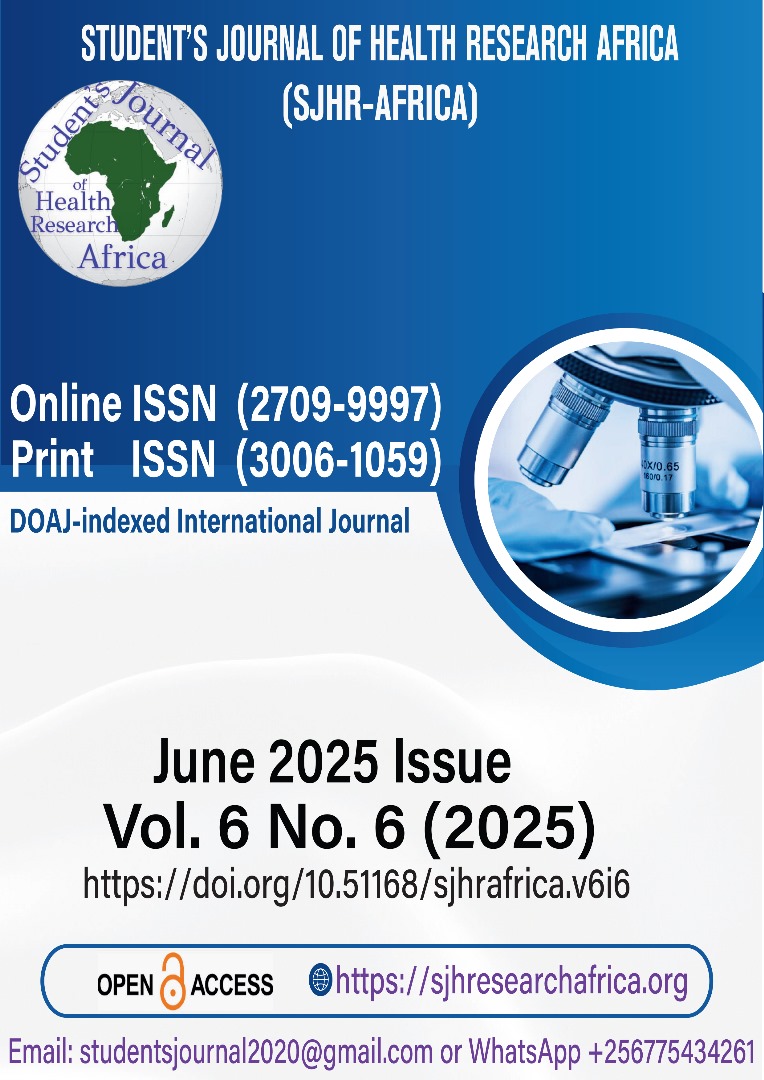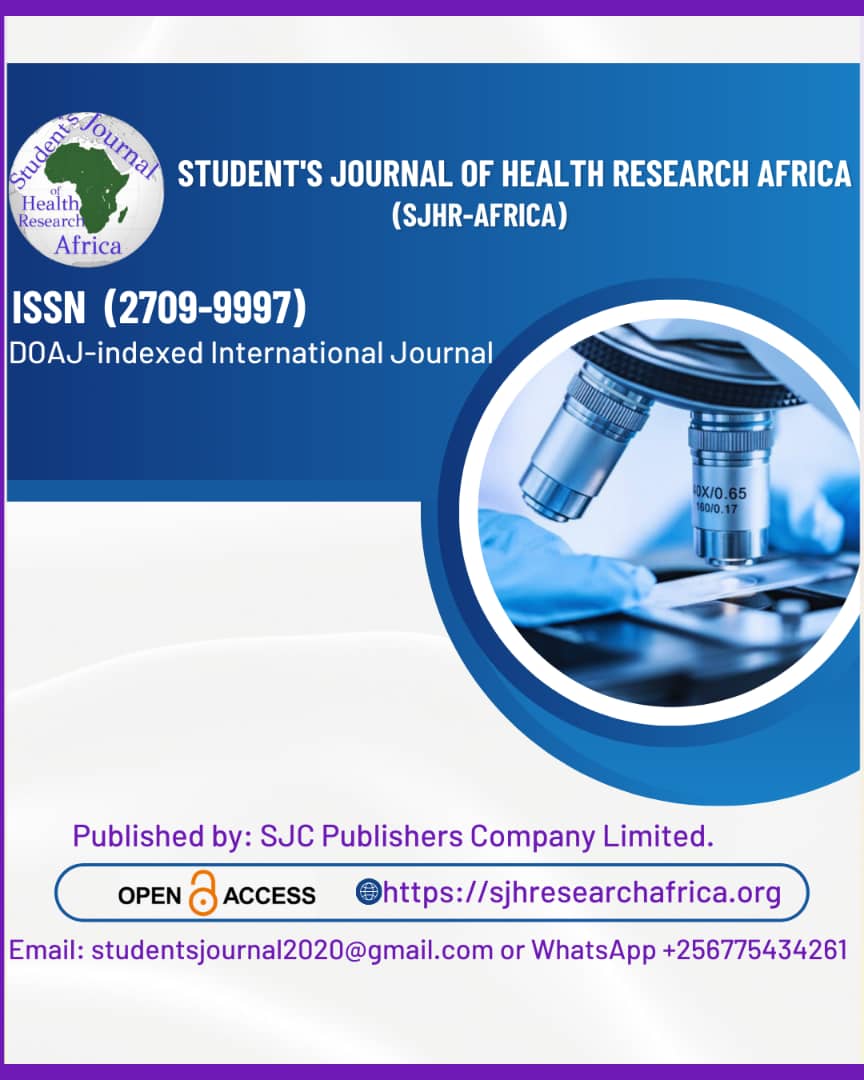DYNAMIC CHANGES IN ALBUMIN AND FIBRINOGEN LEVELS DURING SEPSIS: A PROSPECTIVE OBSERVATIONAL COHORT ANALYSIS.
DOI:
https://doi.org/10.51168/sjhrafrica.v6i6.1707Keywords:
Sepsis, albumin, fibrinogen, hepatic protein synthesis, stable isotope tracer, acute-phase responseAbstract
Background
Sepsis is a major cause of morbidity and mortality in critically ill patients, especially in low- and middle-income countries like India. Albumin and fibrinogen are key plasma proteins with opposing kinetic responses during inflammation and may serve as useful biomarkers in sepsis. This study aims to evaluate the kinetics of albumin and fibrinogen in septic patients to better understand their correlation with disease severity and outcomes.
Methods
This prospective, observational, comparative study was conducted at RIMS, Ranchi, over 12 months. Fifty-five patients (37 septic, 18 non-septic) were enrolled. Hepatic protein synthesis was assessed using stable isotope-labeled L-[ring-²H₅] phenylalanine infusion, followed by GC-MS analysis to determine FSR and ASR of albumin and fibrinogen.
Results
Septic patients had significantly lower plasma albumin and higher fibrinogen levels (p < 0.001). Albumin FSR was elevated (p = 0.03) without a significant change in ASR (p = 0.42), while both FSR and ASR of fibrinogen were significantly increased (p = 0.01, <0.001). The albumin/fibrinogen ASR ratio was markedly reduced (p < 0.001), indicating a shift toward acute-phase protein production in sepsis.
Conclusion
Sepsis is associated with hypoalbuminemia despite increased synthesis, likely due to elevated clearance. Hepatic protein synthesis shifts toward fibrinogen, reflecting a prioritized acute-phase response.
Recommendation
Future research with larger, multi-center cohorts is recommended to validate these findings and further investigate the biochemical differences between septic and non-septic patients. Exploring hepatic protein synthesis parameters may also offer valuable insights for clinical applications in sepsis management.
References
Jeganathan N. Burden of sepsis in India. Chest. 2022 Jun 1;161(6):1438-9. https://doi.org/10.1016/j.chest.2022.02.008
Todi S, Mehta Y, Zirpe K, Dixit S, Kulkarni AP, Gurav S, Chandankhede SR, Govil D, Saha A, Saha AK, Arunachala S. A multicentre prospective registry of one thousand sepsis patients admitted in Indian ICUs:(SEPSIS INDIA) study. Critical Care. 2024 Nov 19;28(1):375. https://doi.org/10.1186/s13054-024-05176-8
Artigas A, Wernerman J, Arroyo V, Vincent JL, Levy M. Role of albumin in diseases associated with severe systemic inflammation: pathophysiologic and clinical evidence in sepsis and in decompensated cirrhosis. Journal of critical care. 2016 Jun 1;33:62-70. https://doi.org/10.1016/j.jcrc.2015.12.019
Matsubara T, Yamakawa K, Umemura Y, Gando S, Ogura H, Shiraishi A, Kushimoto S, Abe T, Tarui T, Hagiwara A, Otomo Y. Significance of plasma fibrinogen level and antithrombin activity in sepsis: a multicenter cohort study using a cubic spline model. Thrombosis research. 2019 Sep 1;181:17-23. https://doi.org/10.1016/j.thromres.2019.07.002
Schupp T, Weidner K, Rusnak J, Jawhar S, Forner J, Dulatahu F, Brück LM, Lübke J, Hoffmann U, Bertsch T, Behnes M. Fibrinogen reflects severity and predicts outcomes in patients with sepsis and septic shock. Blood Coagulation & Fibrinolysis. 2023 Apr 1;34(3):161-70. https://doi.org/10.1080/09537104.2022.2131753
Caironi P, Tognoni G, Masson S, Fumagalli R, Pesenti A, Romero M, Fanizza C, Caspani L, Faenza S, Grasselli G, Iapichino G. Albumin replacement in patients with severe sepsis or septic shock. New England Journal of Medicine. 2014 Apr 10;370(15):1412-21. https://doi.org/10.1056/NEJMoa1305727
Castillo L, Yu YM, Marchini JS, Chapman TE, Sanchez M, Young VR, Burke JF. Phenylalanine and tyrosine kinetics in critically ill children with sepsis. Pediatric research. 1994 May;35(5):580-8. https://doi.org/10.1203/00006450-199405000-00009
Omiya K, Sato H, Sato T, Wykes L, Hong M, Hatzakorzian R, Kristof AS, Schricker T. Albumin and fibrinogen kinetics in sepsis: a prospective observational study. Crit Care. 2021 Dec 17;25(1):436. doi: 10.1186/s13054-021-03860-7. PMID: 34920728; PMCID: PMC8684235. https://doi.org/10.1186/s13054-021-03860-7
Arroyo V, García-Martinez R, Salvatella X. Human serum albumin, systemic inflammation, and cirrhosis. Journal of Hepatology. 2014 Aug 1;61(2):396-407. https://doi.org/10.1016/j.jhep.2014.04.012
Sheinenzon A, Shehadeh M, Michelis R, Shaoul E, Ronen O. Serum albumin levels and inflammation. International journal of biological macromolecules. 2021 Aug 1;184:857-62. https://doi.org/10.1016/j.ijbiomac.2021.06.140
Soeters PB, Wolfe RR, Shenkin A. Hypoalbuminemia: pathogenesis and clinical significance. Journal of Parenteral and Enteral Nutrition. 2019 Feb;43(2):181-93. https://doi.org/10.1002/jpen.1451
Wiedermann CJ. Hypoalbuminemia as surrogate and culprit of infections. International journal of molecular sciences. 2021 Apr 26;22(9):4496. https://doi.org/10.3390/ijms22094496
Lobo SM, Lobo FR. Markers and mediators of inflammatory response in infection and sepsis. Revista Brasileira de terapia intensiva. 2007;19:210-5. https://doi.org/10.1590/S0103-507X2007000200012
Dumitrescu G. Coagulation in liver failure: the role of thromboelastometry and fibrinogen (Doctoral dissertation, Karolinska Institutet (Sweden)).
Li S, Shen Y, Chang B, Wang N. Prognostic Value of Albumin‐to‐Fibrinogen Ratio for 28‐Day Mortality among Patients with Sepsis from Various Infection Sites. Mediators of Inflammation. 2022;2022(1):3578528. https://doi.org/10.1155/2022/3578528
Downloads
Published
How to Cite
Issue
Section
License
Copyright (c) 2025 Jag Mohan Kumar, Kunal Raj, Lal Chand Tudu, Pradip Kumar Bhattacharya, Amit Kumar

This work is licensed under a Creative Commons Attribution-NonCommercial-NoDerivatives 4.0 International License.






















